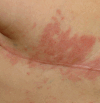Cutaneous metastases of visceral tumours: a review
- PMID: 18560891
- PMCID: PMC12160230
- DOI: 10.1007/s00432-008-0432-0
Cutaneous metastases of visceral tumours: a review
Abstract
Background: Up to 10% of all visceral malignancies develop cutaneous metastases. As cutaneous metastases are underestimated and underdiagnosed they can be a clinical challenge. The clinical appearance and patterns of distribution of cutaneous metastases, the characterisation of clinical outcomes and available therapeutic options are compiled.
Patients and methods: Literature (over the last 6 years) MESH in terms of cutaneous metastases was comprehensively evaluated. Characteristics from 92 available cases are elaborated and adjusted with terms (time unlimited) of published epidemiological reviews to single organs.
Results: The broad clinical spectrum with differential diagnoses is displayed. An allocation of cutaneous metastases and a particular organ is not reliable. In 22% of all cases cutaneous metastases can lead to the diagnosis of an internal malignoma. The majority of cases reveal cutaneous metastases to emerge in a tumour-free interval in about 36 months, after a successful treatment of the primary tumour, most commonly along with other organ metastases. Probable survival turned out to be less than 12 months. Consistently with this end-stage condition, treatment aligns with rules of palliation. Local treatment of choice is excision. Only a minority of investigators attempted to come up with tumour-specific treatment strategies, and almost no randomised therapy studies can be presented.
Conclusion: A reference guide of cutaneous metastases is given; the clinical spectrum is adjusted to an actual status; state of the art of the treatment is accomplished. An epidemiological, improved registration and diagnostic work-up for targeted therapies in conjunction with dermatologists are favoured.
Figures






References
-
- Acikalin MF, Vardareli E, Tel N et al (2005) Erysipelas-like cutaneous metastasis from gastric signet ring cell carcinoma. J Eur Acad Dermatol Venereol 19:642–643. doi:10.1111/j.1468-3083.2005.01214.x - PubMed
-
- Ackerman D, Barr RJ, Elias AN (2001) Cutaneous metastases from hepatocellular carcinoma. Int J Dermatol 40:782–784. doi:10.1046/j.1365-4362.2001.01319.x - PubMed
-
- Aguilar A, Schoendorff C, Lopez Redondo MJ et al (1991) Epidermotropic metastases from internal carcinomas. Am J Dermatopathol 13:452–458 - PubMed
-
- Akman Y, Cam K, Kavak A et al (2003) Extensive cutaneous metastasis of transitional cell carcinoma of the bladder. Int J Urol 10:103–104. doi:10.1046/j.1442-2042.2003.00571.x - PubMed
Publication types
MeSH terms
LinkOut - more resources
Full Text Sources
Other Literature Sources
Medical
Research Materials

